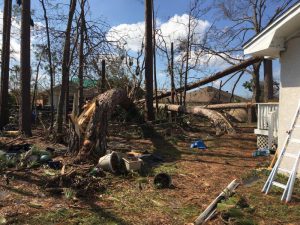The aftermath of Hurricane Michael has many homeowners preparing their landscapes for the upcoming season. Several have called the office in need of a home visit because they want ideas of what to replant with and how to kill the weeds that have popped up. One common question is, “What trees can I plant that are fast growing and has plenty of shade?” Before I answer their question, I ask them, “Are you planning for future storms or not?”
Trees that are considered ‘fast’ growing are not necessarily the best choice for future storms. Many of the fast growing trees can be easily uprooted, break easily in strong winds, are more prone to decay, and/or are rather short-lived (<50 years old). Additionally, a missing structural pruning plan for young and mature trees will increase the chances of fallen trees. Homeowners can expect to replant trees once again if these characteristics are likely. Keep in mind that no tree is absolutely wind-proof since other factors need to be ideal for wind-resistance. Trees like laurel oak (Quercus laurifolia), water oak (Quercus nigra), cherry laurel (Prunus caroliniana), bradford pear (Pyrus calleryana), and pecan (Carya illinoensis) are some to be cautious of when replanting for wind resistance.
A few tips for homeowners re-planting hurricane damaged trees:
- Plant trees with higher wind resistance in groups with adequate soil space and soil properties.
- Prevent damage to the roots.
- Have a variety of native species, ages, and layers of high-quality trees and shrubs.
- Some of the best trees a homeowner should consider replanting with could be live oak (Quercus virginiana), southern magnolia (Magnolia grandiflora), baldcypress (Taxodium distichum), river birch (Betula nigra), and Japanese maple (Acer palmatum). A more in-depth look at wind resistant trees can be found by reading Wind and Trees: Lessons Learned from Hurricanes.FOR 118
.
- Natural Walls - May 27, 2019
- A Bloom Prettier than the Moon - April 16, 2019
- Tree Replanting Considerations - March 26, 2019

